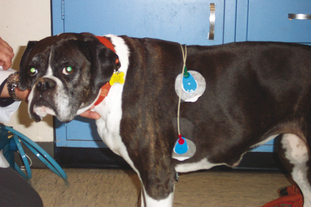Chapter 5 Special Diagnostic Techniques for Evaluation of Cardiac Disease*
CONTINUOUS IN-HOSPITAL ELECTROCARDIOGRAPHIC MONITORING
Technique
• Place the positive electrode patch at the left apical site and the negative electrode at the heart base site. A ground electrode may be placed at either site (Figure 5-1).
• Depending on the unit available, the signal is transmitted to the machine by cables or by radiotelemetry.
PROVOCATIVE ELECTROCARDIOGRAPHIC TECHNIQUES
Clinical Utility
Vagal Maneuver
Clinically useful in two scenarios:
• In the evaluation of dogs with a history of syncope, a vagal maneuver may demonstrate sinus arrest or AV block, suggestive of parasympathetic hypersensitivity or primary nodal disease.




